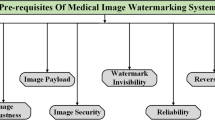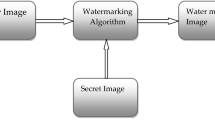Abstract
The current work is focused on the implementation of a robust multimedia application for watermarking digital images, which is based on an innovative spread spectrum analysis algorithm for watermark embedding and on a content-based image retrieval technique for watermark detection. The existing highly robust watermark algorithms are applying “detectable watermarks” for which a detection mechanism checks if the watermark exists or not (a Boolean decision) based on a watermarking key. The problem is that the detection of a watermark in a digital image library containing thousands of images means that the watermark detection algorithm is necessary to apply all the keys to the digital images. This application is non-efficient for very large image databases. On the other hand “readable” watermarks may prove weaker but easier to detect as only the detection mechanism is required. The proposed watermarking algorithm combine’s the advantages of both “detectable” and “readable” watermarks. The result is a fast and robust multimedia application which has the ability to cast readable multibit watermarks into digital images. The watermarking application is capable of hiding 214 different keys into digital images and casting multiple zero-bit watermarks onto the same coefficient area while maintaining a sufficient level of robustness.






Similar content being viewed by others
References
Barni M, Bartolini F, Cappellini V, Piva A (1998) A DCT-domain system for robust image watermarking. Signal Processing, “Special Issue on Watermarking”, 66(3):357–372
Computer Science and Telecommunications Board, National Research Council (1999) The digital dilemma: intellectual property in the information age. National Academy Press, Washington, pp 2–3
Cox IJ, Miller ML, Bloom JA (2002) Digital Watermarking. Morgan Kaufann Publishers
Holt B, Weiss K, Niblack W, Flickner M, and Petkovic D (2002) The QBIC Project in the Department of Art and Art History at UC Davis, University of California, Davis, California, IBM Almaden Research Center, IBM Corporation, San Jose, California (http://www.asis.org/annual-97/holt.htm)
House of Representatives. (1998) Digital millennium copyright act, Οκτώβριος
Kalker T (2001) Considerations on watermarking security. In IEEE Multimedia Signal Pro-cessing, MMSP01 Workshop. Cannes, France, pp 201–206
Katzenbeisser S, Petitcolas FAP (2000) Information hiding - techniques for steganography and digital watermarking. Artech House, Computer Series, pp 95–172
Kutter M, Petitcolas FAP (1999) A fair benchmark for image watermarking systems. Electronic Imaging ’99, Security and Watermarking of Multimedia Contents, Sans Jose, CA, USA, 25–27 January 1999
Tsolis GK, Tsolis DK, Papatheodorou TS (2001) A watermarking environment and a metadata digital image repository for the protection and management of digital images of the Hellenic cultural heritage. IEEE, International Conference on Image Processing 2001 (ICIP 2001), Image Processing and Cultural Heritage, 2001
Wayner P (2002) Disappearing cryptography – information hiding: steganography and watermarking, 2nd edn. Morgan Kaufmann, pp 291–318
Author information
Authors and Affiliations
Corresponding author
Rights and permissions
About this article
Cite this article
Tsolis, D.K., Sioutas, S. & Papatheodorou, T.S. A multimedia application for watermarking digital images based on a content based image retrieval technique. Multimed Tools Appl 47, 581–597 (2010). https://doi.org/10.1007/s11042-009-0338-0
Published:
Issue Date:
DOI: https://doi.org/10.1007/s11042-009-0338-0




